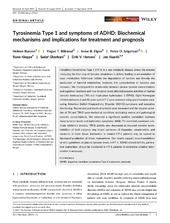| dc.contributor.author | Barone, Helene | en_US |
| dc.contributor.author | Bliksrud, Yngve Thomas | en_US |
| dc.contributor.author | Elgen, Irene Bircow | en_US |
| dc.contributor.author | Szigetvari, Peter Daniel | en_US |
| dc.contributor.author | Kleppe, Rune | en_US |
| dc.contributor.author | Ghorbani, Sadaf | en_US |
| dc.contributor.author | Hansen, Eirik Vangsøy | en_US |
| dc.contributor.author | Haavik, Jan | en_US |
| dc.date.accessioned | 2020-04-15T10:52:21Z | |
| dc.date.available | 2020-04-15T10:52:21Z | |
| dc.date.issued | 2020 | |
| dc.identifier.issn | 0148-7299 | |
| dc.identifier.issn | 1096-8628 | |
| dc.identifier.uri | https://hdl.handle.net/1956/21865 | |
| dc.description.abstract | Hereditary tyrosinemia Type 1 (HT‐1) is a rare metabolic disease where the enzyme catalyzing the final step of tyrosine breakdown is defect, leading to accumulation of toxic metabolites. Nitisinone inhibits the degradation of tyrosine and thereby the production of harmful metabolites, however, the concentration of tyrosine also increases. We investigated the relationship between plasma tyrosine concentrations and cognitive functions and how tyrosine levels affected enzyme activities of human tyrosine hydroxylase (TH) and tryptophan hydroxylase 2 (TPH2). Eight Norwegian children between 6 and 18 years with HT‐1 were assessed using questionnaires measuring Attention Deficit Hyperactivity Disorder (ADHD)‐symptoms and executive functioning. Recent and past levels of tyrosine were measured and the enzyme activities of TH and TPH2 were studied at conditions replicating normal and pathological tyrosine concentrations. We observed a significant positive correlation between mean tyrosine levels and inattention symptoms. While TH exhibited prominent substrate inhibition kinetics, TPH2 activity also decreased at elevated tyrosine levels. Inhibition of both enzymes may impair syntheses of dopamine, noradrenaline, and serotonin in brain tissue. Inattention in treated HT‐1 patients may be related to decreased production of these monoamines. Our results support recommendations of strict guidelines on plasma tyrosine levels in HT‐1. ADHD‐related deficits, particularly inattention, should be monitored in HT‐1 patients to determine whether intervention is necessary. | en_US |
| dc.language.iso | eng | eng |
| dc.publisher | Wiley | eng |
| dc.rights | Attribution CC BY | eng |
| dc.rights.uri | http://creativecommons.org/licenses/by/4.0/ | eng |
| dc.subject | ADHD | eng |
| dc.subject | dopamine | eng |
| dc.subject | hereditary tyrosinemia Type 1 | eng |
| dc.subject | inattention | eng |
| dc.subject | serotonin | eng |
| dc.title | Tyrosinemia Type 1 and symptoms of ADHD: Biochemical mechanisms and implications for treatment and prognosis | en_US |
| dc.type | Peer reviewed | |
| dc.type | Journal article | |
| dc.date.updated | 2019-12-11T12:07:06Z | |
| dc.description.version | publishedVersion | en_US |
| dc.rights.holder | Copyright 2019 The Author(s) | |
| dc.identifier.doi | https://doi.org/10.1002/ajmg.b.32764 | |
| dc.identifier.cristin | 1759290 | |
| dc.source.journal | American Journal of Medical Genetics | |
| dc.source.pagenumber | 95-105 | |
| dc.identifier.citation | American Journal of Medical Genetics B. 2020, 183 (2), 95-105. | |
| dc.source.volume | 183 | |
| dc.source.issue | 2 | |

